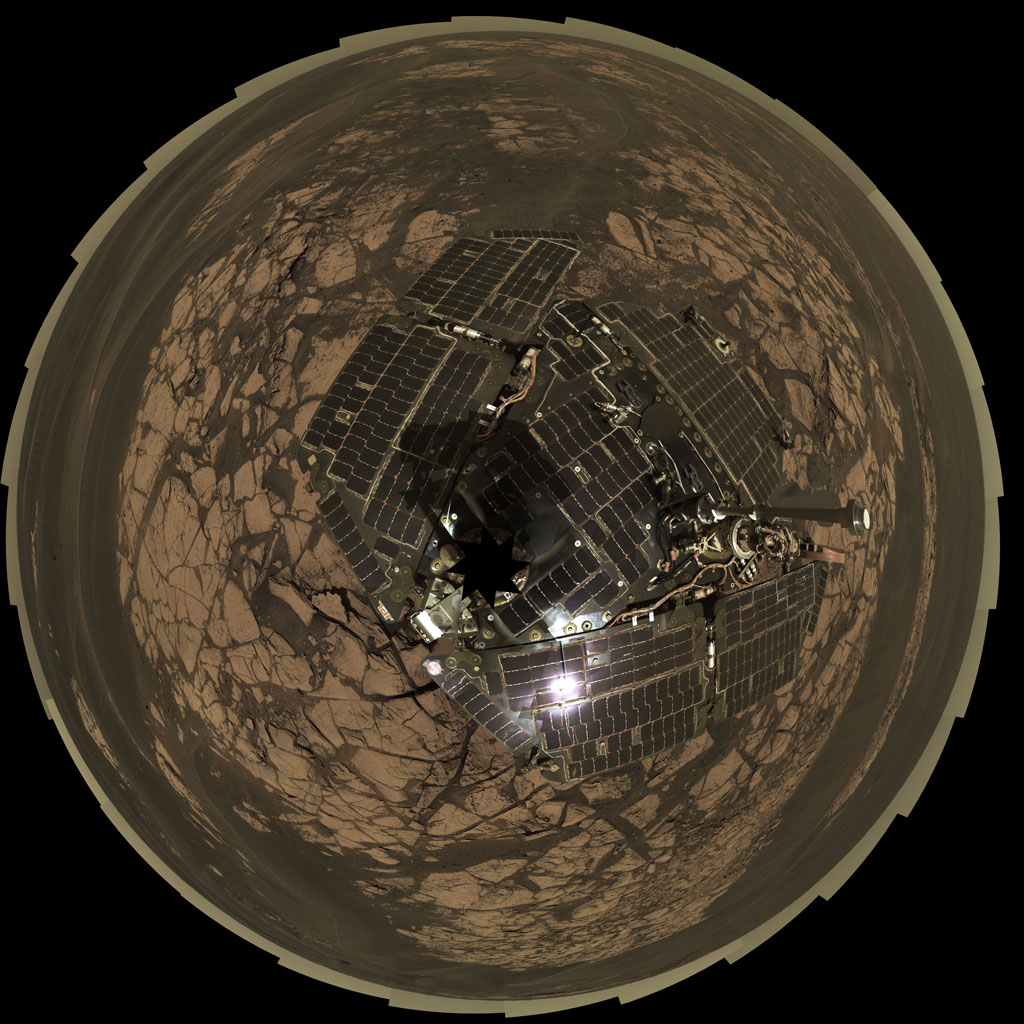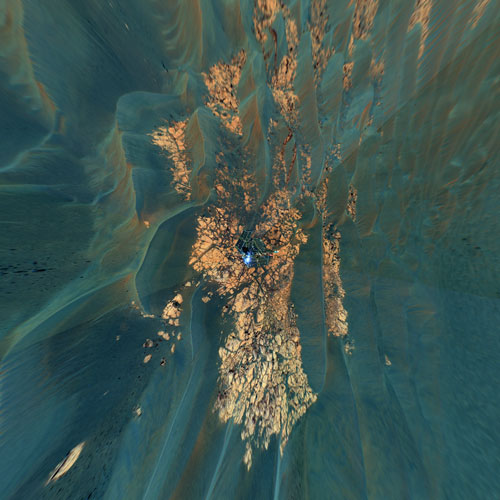
"Erebus Panorama"
This is the Opportunity panoramic camera's "Erebus Rim" panorama, acquired on sols 652 to 663 (Nov. 23 to Dec. 5, 2005 ), as NASA's Mars Exploration Rover Opportunity was exploring sand dunes and outcrop rocks in Meridiani Planum. The panorama originally consisted of 635 separate images in 4 different Pancam filters, and covers 360 degrees of terrain around the rover and the full rover deck. Since the time that this panorama was acquired, and while engineers have been diagnosing and testing Opportunity's robotic arm, the panorama has been expanded to include more than 1,300 images of this terrain through all of the Pancam multispectral filters. It is the largest panorama acquired by either rover during the mission.
The panorama shown here is an approximate true-color rendering using Pancam's 750 nanometer, 530 nanometer and 430 nanometer filters. It is presented here as a cylindrical projection. Image-to-image seams have been eliminated from the sky portion of the mosaic to better simulate the vista a person standing on Mars would see.
This panorama provides the team's highest resolution view yet of the finely-layered outcrop rocks, wind ripples, and small cobbles and grains along the rim of the wide but shallow "Erebus" crater. Once the arm diagnostics and testing are completed, the team hopes to explore other layered outcrop rocks at Erebus and then eventually continue southward toward the large crater known as "Victoria."
Jim Bell
Pancam PEL
01 January 2006
Image credit: NASA/JPL/Cornell
Image mosaicking: JPL/MIPL Team (Bob Deen, Oleg Pariser, Jeffrey Hall)
Calibration and color rendering:Cornell Calibration Crew and the Pancam team (Jim Bell)
Full Size JPG | Full Size TIFF
Image Dimensions: 22780x5996

"Erebus" (stereo version)
This stereo view shows the landscape surrounding NASA's Mars Exploration Rover Opportunity at the edge of "Erebus Crater" while the rover's panoramic camera captured frames for a full-circle panorama on Opportunity's sols 652 to 663 (Nov. 23 to Dec. 5, 2005 ). The scene includes finely-layered outcrop rocks, wind ripples, and small cobbles and grains along the rim of the wide but shallow crater.
This image appears three dimensional when viewed through red and blue glasses with a red left eye and blue right eye. Both the left and right images were taken through blue filters. The view is presented in a cylindrical-perspective projection.
Image credit: NASA/JPL-Caltech/Cornell
Full Size JPG
Image Dimensions: 26306x3000


"Erebus" (polar and vertical projections)
The left view combines frames taken by the panoramic camera (Pancam) on NASA's Mars Exploration Rover Opportunity on the rover's 652nd through 663rd Martian days, or sols (Nov. 23 to Dec. 5, 2005), at the edge of "Erebus Crater." The mosaic is presented as a polar projection. This type of projection provides a kind of overhead view of all of the surrounding terrain. Opportunity examined targets on the outcrop called "Rimrock" in front of the rover, testing the mobility and operation of Opportunity's robotic arm. The view shows examples of the dunes and ripples that Opportunity has been crossing as the rover drives on the Meridiani plains.
This view is an approximate true color rendering composed of images taken through the camera's 750-nanometer, 530-nanometer and 430-nanometer filters.
The view to the right combines frames taken by the panoramic camera on NASA's Mars Exploration Rover Opportunity on the rover's 652nd through 663rd Martian days, or sols (Nov. 23 to Dec. 5, 2005), at the edge of "Erebus Crater." The mosaic is presented as a vertical projection. This type of projection provides a true-to-scale overhead view of the rover deck and nearby surrounding terrain. The view here shows outcrop rocks, sand dunes, and other features out to a distance of about 25 meters (82 feet) from the rover. Opportunity examined targets on the outcrop called "Rimrock" in front of the rover, testing the mobility and operation of Opportunity's robotic arm. The view shows examples of the dunes and ripples that Opportunity has been crossing as the rover drives on the Meridiani plains.
This view is a false-color composite of images taken through the camera's 750-nanometer, 530-nanometer and 430-nanometer filters. This kind of false-color scheme emphasizes differences in composition among the different kinds of materials that the rover is exploring.
Jim Bell
Pancam PEL
01 January 2006
Image credit: NASA/JPL/Cornell
Image mosaicking: JPL/MIPL Team (Bob Deen, Oleg Pariser, Jeffrey Hall)
Calibration and color rendering:Cornell Calibration Crew and the Pancam team (Jim Bell)
Full Size JPG (polar) | Full Size TIFF (polar)
Image Dimensions: 12097x12097
Full Size JPG (vertical) | Full Size TIFF (vertical)
Image Dimensions: 10000x10000
Back to Panoramas




